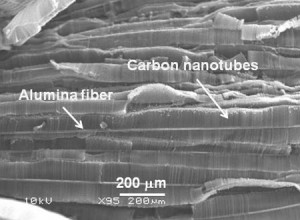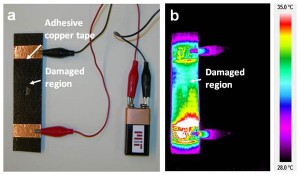Preventing Catastrophic Failures: Nano-engineered Multi-physics Structural-damage Detection
Catastrophic structural failures are the cause of many physical and personal losses every year, with prevention estimated at billions of dollars each year. Non-destructive evaluation (NDE) techniques have been pursued and employed for damage detection of such structures to detect cracks and other damage at pre-critical levels for remediation [1] [2]. Here, a novel multi-physics approach is reported that addresses these drawbacks by taking advantage of the effects that damage, such as a crack, has on the electric and thermal transport in a material containing aligned carbon nanotubes (CNTs). When a different of potential is applied to a nano-engineered structure (Figure 1), electric field lines concentrate in the vicinity of cracks as electrons flow around damage, causing field concentrations and “hot spots” via Joule heating, an effect which is amplified because the heat flow is also impeded in areas of damage. These changes of temperature can be localized through a conventional thermal camera. Low-power operation (a 9V standard battery is exemplary, providing a 15C rise at 1 Watt, as in Figure 2) and high spatial resolution is demonstrated that is beyond state-of-the-art in non-destructive evaluation.
Multiple applications have been identified using this technique such as crack detection in composite components that are joined by metallic fasteners, structures impacted with internal damage, and in-situ progressive damage monitoring during a tensile strength test. The thermal nano-engineered NDE technique demonstrated here can provide a new and effective inspection route for monitoring next-generations of safer infrastructure [3] [4].
- Figure 1: Nano-engineered material and its components. Aligned CNTs grown directly on the surface of an alumina fiber cloth.
- Figure 2: Power and resolution characteristics of nano-engineered non-destructive evaluation technique: optical image (thermograph) of a composite specimen damaged powered by a 9V battery. In the thermograph a change of temperature can be seen, indicating the damaged area.
References
- D. Barber, S. Wicks, A. Raghavan, C. T. Dunn,, S.S. Kessler, and B.L. Wardle, “Health Monitoring of Aligned Carbon Nanotube (CNT) Enhanced Composites,” Paper # F031 in 2009 SAMPE Fall Technical Conference, Wichita, KS, Oct. 2009. [↩]
- S. Wicks, A. Raghavan,, R. Guzmán de Villoria, S.S. Kessler, and B.L. Wardle, “Tomographic Electrical Resistance-based Damage Sensing in Nano-Engineered Composite Structures,” in AIAA-2010-2871, 51st AIAA Structures, Structural Dynamics, and Materials (SDM) Conference, Orlando, FL, Apr. 12-15, 2010. [↩]
- R. Guzman de Villoria, N. Yamamoto, A. Miravete, and B.L.W. Wardle “Preventing Catastrophic Failures: Nano-Engineered Multi-Physics Materials for Damage Detection,” submitted to ACS Nano, 2010. [↩]
- B.L. Wardle, and R. Guzman de Villoria, “Systems and Methods for Structural Sensing,” U.S. Provisional Patent Application 61/259,925, Utility Patent filed Nov. 2009. [↩]

